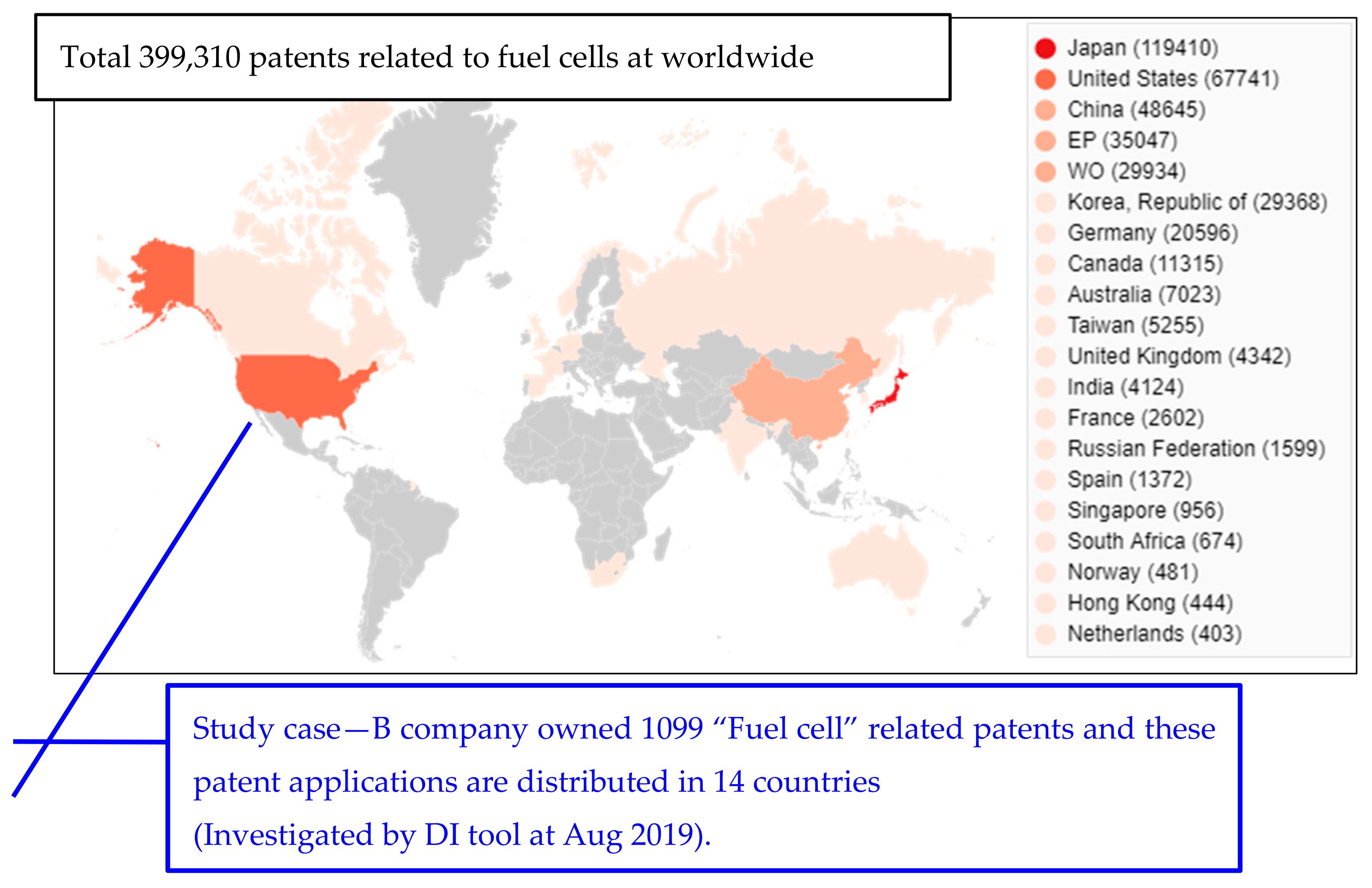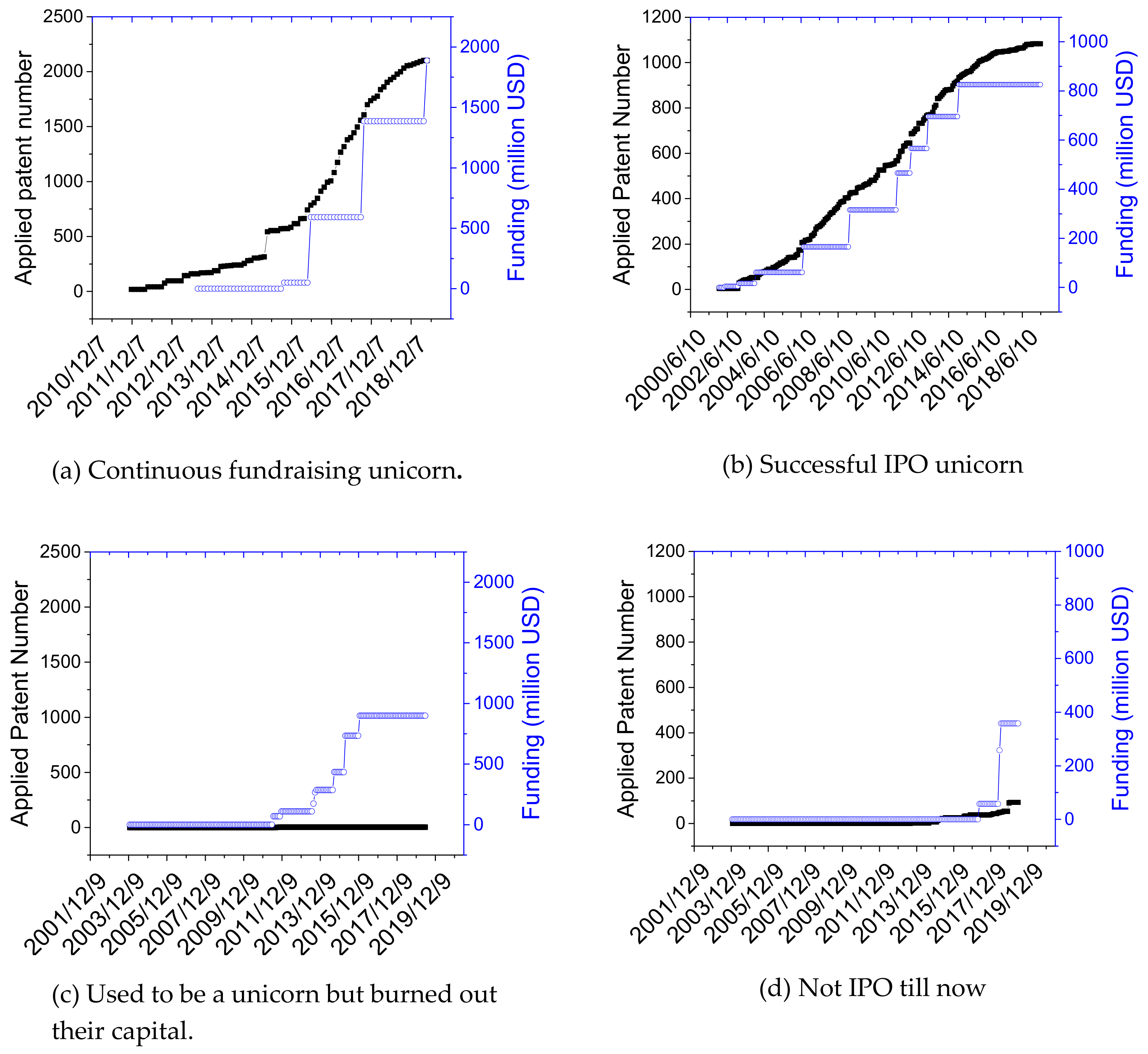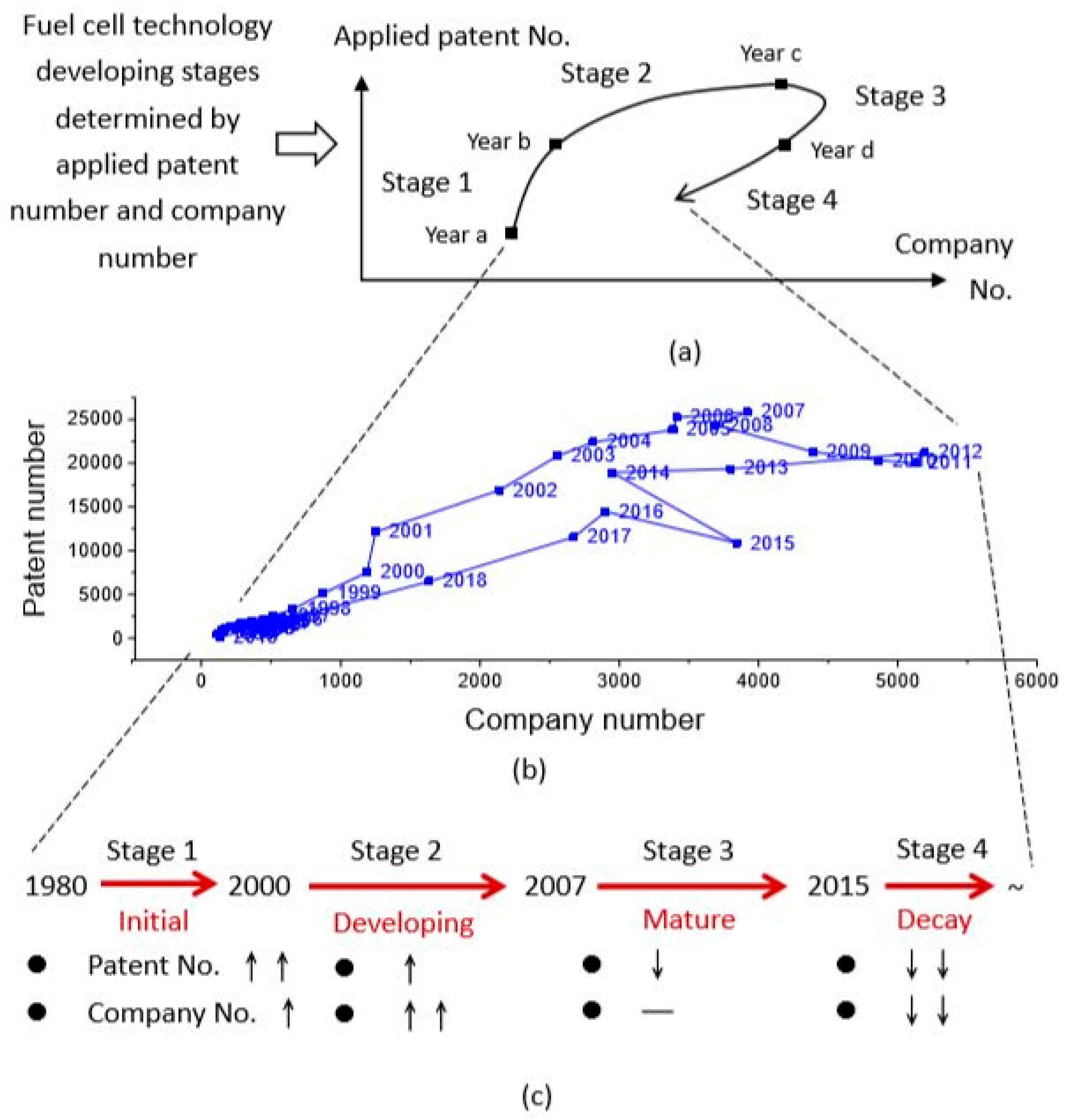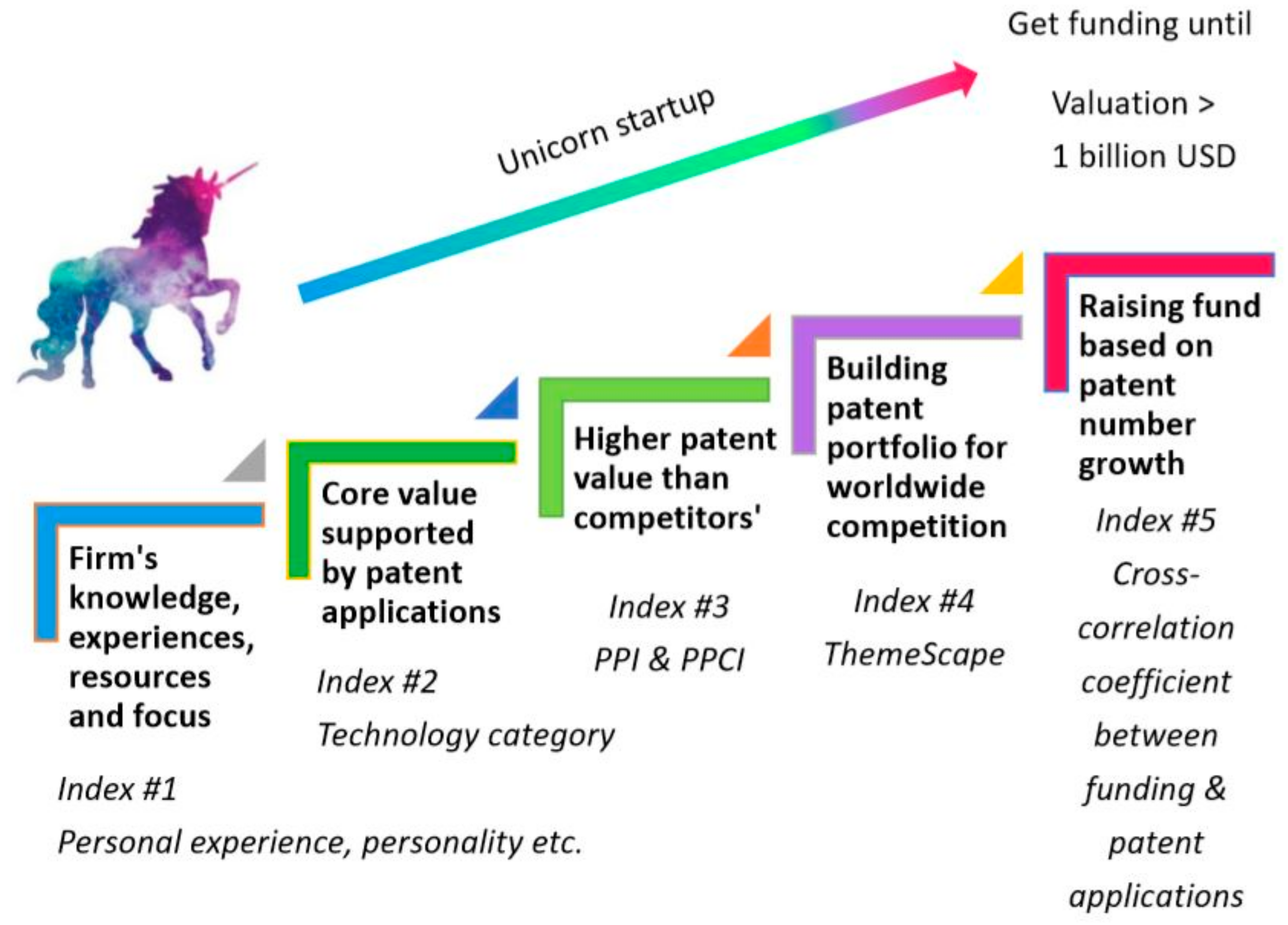How to Transform Sustainable Energy Technology into a Unicorn Start-Up: Technology Review and Case Study
Abstract
1. Introduction
- Commercialization of renewable and sustainable technologies
- Unicorn start-up definition and status
- Technology review of fuel cells
- SOFC commercialization by the case company
- Competitors
- Features of unicorn start-ups
- Patent analytics
- Landscape drawing
- Quantitative indices
- Ladder framework for commercialization
2. Fundamental Analysis
2.1. Commercialization of Renewable and Sustainable Technologies
2.2. Unicorn Start-up Definition and Status
2.3. Technology Review of Fuel Cells
3. The Study Case
3.1. SOFC Commercialization by the Case Company
3.2. Competitors
4. Methodology and Research Settings
4.1. Features of Unicorn Start-ups
4.2. Patent Analytics
4.3. Landscape Drawing
4.4. Quantitative Indices
4.5. Ladder Framework for Commercialization
5. Results and Discussion
5.1. Ladder Framework for Commercialization of a Unicorn Start-up
5.1.1. Index #1. Personal Experience
5.1.2. Index #2. Technology Category
5.1.3. Index #3. PPI and PPCI
5.1.4. Index #4. ThemeScape
5.1.5. Index #5. Cross-correlation Coefficient between Funding and Patent Applications
5.2. Study Limitations
6. Conclusions
Supplementary Materials
Author Contributions
Acknowledgments
Conflicts of Interest
Abbreviations
| AFC | Alkaline Fuel Cell |
| DI | Derwent Innovation |
| DMFC | Direct Methane Fuel Cell |
| DOE | Department of Energy |
| FC | Fuel Cell |
| IEL | IEEE/IET Library |
| IP | Intellectual Property |
| IPO | Initial Public Offering |
| MCFC | Molten Carbonate Fuel Cell |
| PAFC | Phosphoric Acid Fuel Cell |
| PEMFC | Proton Exchange Membrane Fuel Cell |
| PPCI | Patent Portfolio Competition Index |
| PPI | Patent Power Index |
| R&D | Research and Development |
| RET | Renewable Energy Technology |
| SDOL | Science Direction On Line |
| SET | Sustainable Energy Technology |
| SOFC | Solid Oxide Fuel Cell |
References
- Available online: https://en.wikipedia.org/wiki/Commercialisation (accessed on 22 October 2019).
- Balachandra, P.; Kristle Nathan, H.S.; Reddy, B.S. Commercialisation of sustainable energy technologies. Renew. Energy 2010, 35, 1842–1851. [Google Scholar] [CrossRef]
- Shakeel, S.R.; Takala, J.; Zhu, L.D. Commercialisation of renewable energy technologies: A ladder building approach. Renew. Sustain. Energy Rev. 2017, 78, 855–867. [Google Scholar] [CrossRef]
- Symeonidou, N.; Bruneel, J.; Autio, E. Commercialisation strategy and internationalization outcomes in technology-based new ventures. J. Bus. Ventur. 2017, 32, 302–317. [Google Scholar] [CrossRef]
- Available online: https://www.cbinsights.com/ (accessed on 31 October 2019).
- Available online: https://en.wikipedia.org/wiki/Fuel_cell (accessed on 23 October 2019).
- Brown, J.T. Solid oxide fuel cell technology. IEEE Trans. Energy Convers. 1988, 3, 193–198. [Google Scholar] [CrossRef]
- Stann, I. Fuel cells are coming to town. Power Eng. J. 1992, 6, 107. [Google Scholar] [CrossRef]
- Hirschenhofer, J.H. Fuel Cell Status. IEEE Aerosp. Electron. Syst. Mag. 1994. [Google Scholar] [CrossRef]
- Hirschenhofer, J.H. Fuel Cell Status: 1996. IEEE Aerosp. Electron. Syst. Mag. 1997, 12, 23–28. [Google Scholar] [CrossRef]
- T-Raissi, A.; Banerjee, A.; Sheinkopf, K.G. Current Technology of Fuel Cell Systems. In Proceedings of the Thirty-Second Intersociety Energy Conversion Engineering Conference (Cat. No. 97CH6203), Honolulu, HI, USA, 27 July–1 August 1997; pp. 1953–1957. [Google Scholar]
- Singhal, S.C. Advances in solid oxide fuel cell technology. Solid State Ionics 2000, 135, 305–313. [Google Scholar] [CrossRef]
- Zhu, W.Z.; Deevi, S.C. A review on the status of anode materials for solid oxide fuel cells. Mater. Sci. Eng. A 2003, 362, 228–239. [Google Scholar] [CrossRef]
- Shri Prakash, B.; Senthil Kumar, S.; Aruna, S.T. Properties and development of Ni/YSZ as an anode material in solid oxide fuel cell: A review. Renew. Sustain. Energy Rev. 2014, 36, 149–179. [Google Scholar] [CrossRef]
- Shaikh, S.P.S.; Muchtar, A.; Somalu, M.R. A review on the selection of anode materials for solid-oxide fuel cells. Renew. Sustain. Energy Rev. 2015, 51, 1–8. [Google Scholar] [CrossRef]
- Mahato, N.; Banerjee, A.; Gupta, A.; Omar, S.; Balani, K. Progress in material selection for solid oxide fuel cell technology: A review. Prog. Mater. Sci. 2015, 72, 141–337. [Google Scholar] [CrossRef]
- Da Silva, F.S.; De Souza, T.M. Novel materials for solid oxide fuel cell technologies: A literature review. Int. J. Hydrogen Energy 2017, 42, 26020–26036. [Google Scholar] [CrossRef]
- Fergus, J.W. Sealants for solid oxide fuel cells. J. Power Sources 2005, 147, 46–57. [Google Scholar] [CrossRef]
- Pederson, L.R.; Singh, P.; Zhou, X.D. Application of vacuum deposition methods to solid oxide fuel cells. Vacuum 2006, 80, 1066–1083. [Google Scholar] [CrossRef]
- Yano, M.; Tomita, A.; Sano, M.; Hibino, T. Recent advances in single-chamber solid oxide fuel cells: A review. Solid State Ionics 2007, 177, 3351–3359. [Google Scholar] [CrossRef]
- Kakaç, S.; Pramuanjaroenkij, A.; Zhou, X.Y. A review of numerical modeling of solid oxide fuel cells. Int. J. Hydrogen Energy 2007, 32, 761–786. [Google Scholar] [CrossRef]
- Wang, K.; Hissel, D.; Péra, M.C.; Steiner, N.; Marra, D.; Sorrentino, M.; Pianese, C.; Monteverde, M.; Cardone, P.; Saarinen, J. A Review on solid oxide fuel cell models. Int. J. Hydrogen Energy 2011, 36, 7212–7228. [Google Scholar] [CrossRef]
- Hajimolana, S.A.; Hussain, M.A.; Daud, W.M.A.W.; Soroush, M.; Shamiri, A. Mathematical modeling of solid oxide fuel cells: A review. Renew. Sustain. Energy Rev. 2011, 15, 1893–1917. [Google Scholar] [CrossRef]
- Laguna-Bercero, M.A. Recent advances in high temperature electrolysis using solid oxide fuel cells: A review. J. Power Sources 2012, 203, 4–16. [Google Scholar] [CrossRef]
- Lee, M.; Park, G.; Radisavljevic-Gajic, V. Modeling of solid oxide fuel cells (SOFCs): An overview. In Proceedings of the 2013 5th International Conference on Modeling, Simulation and Applied Optimization (ICMSAO), Hammamet, Tunisia, 28–30 April 2013; pp. 1–6. [Google Scholar]
- Peksen, M. Numerical thermomechanical modelling of solid oxide fuel cells. Prog. Energy Combust. Sci. 2015, 48, 1–20. [Google Scholar] [CrossRef]
- Sun, C.; Stimming, U. Recent anode advances in solid oxide fuel cells. J. Power Sources 2007, 171, 247–260. [Google Scholar] [CrossRef]
- Riipinen, T.; Väisänen, V.; Kuisma, M.; Seppä, L.; Mustonen, P.; Silventoinen, P. Requirements for power electronics in solid oxide fuel cell system. In Proceedings of the 2008 13th International Power Electronics and Motion Control Conference, Poznan, Poland, 1–3 September 2008; pp. 1233–1238. [Google Scholar]
- Kirubakaran, A.; Nema, R.K.; Jain, S.K. Distributed generation by solid oxide fuel cell: A review. In Proceedings of the 2008 Joint International Conference on Power System Technology POWERCON and IEEE Power India Conference, New Delhi, India, 12–15 October 2008; pp. 1–7. [Google Scholar]
- Choudhury, A.; Chandra, H.; Arora, A. Application of solid oxide fuel cell technology for power generation—A review. Renew. Sustain. Energy Rev. 2013, 20, 430–442. [Google Scholar] [CrossRef]
- Nayak, S.K.; Gaonkar, D.N. Fuel cell based hybrid distributed generation systems, “a review”. In Proceedings of the 2013 IEEE 8th International Conference on Industrial and Information Systems (ICIIS 2013), Kandy, Sri Lanka, 17–20 December 2013; pp. 525–530. [Google Scholar]
- Pramuanjaroenkij, A.; Kakaç, S.; Yang Zhou, X. Mathematical analysis of planar solid oxide fuel cells. Int. J. Hydrogen Energy 2008, 33, 2547–2565. [Google Scholar] [CrossRef]
- Aruna, S.T.; Balaji, L.S.; Kumar, S.S.; Prakash, B.S. Electrospinning in solid oxide fuel cells–A review. Renew. Sustain. Energy Rev. 2017, 67, 673–682. [Google Scholar] [CrossRef]
- Evans, A.; Bieberle-Hütter, A.; Rupp, J.L.M.; Gauckler, L.J. Review on microfabricated micro-solid oxide fuel cell membranes. J. Power Sources 2009, 194, 119–129. [Google Scholar] [CrossRef]
- Gorte, R.J.; Vohs, J.M. Nanostructured anodes for solid oxide fuel cells. Curr. Opin. Colloid Interface Sci. 2009, 14, 236–244. [Google Scholar] [CrossRef]
- Zhang, X.; Chan, S.H.; Li, G.; Ho, H.K.; Li, J.; Feng, Z. A review of integration strategies for solid oxide fuel cells. J. Power Sources 2010, 195, 685–702. [Google Scholar] [CrossRef]
- Tucker, M.C. Progress in metal-supported solid oxide fuel cells: A review. J. Power Sources 2010, 195, 4570–4582. [Google Scholar] [CrossRef]
- Gómez, S.Y.; Hotza, D. Current developments in reversible solid oxide fuel cells. Renew. Sustain. Energy Rev. 2016, 61, 155–174. [Google Scholar] [CrossRef]
- Huang, K.; Singhal, S.C. Cathode-supported tubular solid oxide fuel cell technology: A critical review. J. Power Sources 2013, 237, 84–97. [Google Scholar] [CrossRef]
- Leung, M.; Park, G.; Radisavljevic-Gajic, V. Control of solid oxide fuel cells: An overview. In Proceedings of the 2013 9th Asian Control Conference (ASCC 2013), Istanbul, Turkey, 23–26 June 2013; pp. 1–6. [Google Scholar]
- He, W.; Zou, J.; Wang, B.; Vilayurganapathy, S.; Zhou, M.; Lin, X.; Zhang, K.H.L.; Lin, J.; Xu, P.; Dickerson, J.H. Gas transport in porous electrodes of solid oxide fuel cells: A review on diffusion and diffusivity measurement. J. Power Sources 2013, 237, 64–73. [Google Scholar] [CrossRef]
- Jiang, S.P.; Chen, X. Chromium deposition and poisoning of cathodes of solid oxide fuel cells—A review. Int. J. Hydrogen Energy 2014, 39, 505–531. [Google Scholar] [CrossRef]
- Liu, M.; Aravind, P.V. The fate of tars under solid oxide fuel cell conditions: A review. Appl. Therm. Eng. 2014, 70, 687–693. [Google Scholar] [CrossRef]
- Afif, A.; Radenahmad, N.; Cheok, Q.; Shams, S.; Kim, J.H.; Azad, A.K. Ammonia-fed fuel cells: A comprehensive review. Renew. Sustain. Energy Rev. 2016, 60, 822–835. [Google Scholar] [CrossRef]
- Available online: https://en.wikipedia.org/wiki/Bloom_Energy_Server (accessed on 20 August 2019).
- Van Biert, L.; Godjevac, M.; Visser, K.; Aravind, P.V. A review of fuel cell systems for maritime applications. J. Power Sources 2016, 327, 345–364. [Google Scholar] [CrossRef]
- Dekel, D.R. Review of cell performance in anion exchange membrane fuel cells. J. Power Sources 2018, 375, 158–169. [Google Scholar] [CrossRef]
- Arsalis, A. A comprehensive review of fuel cell-based micro-combined-heat-and-power systems. Renew. Sustain. Energy Rev. 2019, 105, 391–414. [Google Scholar] [CrossRef]
- Yue, M.; Jemei, S.; Gouriveau, R. ScienceDirect Review on health-conscious energy management strategies for fuel cell hybrid electric vehicles: Degradation models and strategies. Int. J. Hydrogen Energy 2019, 44, 6844–6861. [Google Scholar] [CrossRef]
- Chen, H.; Zhao, X.; Zhang, T.; Pei, P. The reactant starvation of the proton exchange membrane fuel cells for vehicular applications: A review. Energy Convers. Manag. 2019, 182, 282–298. [Google Scholar] [CrossRef]
- Shabani, B.; Hafttananian, M.; Khamani, S.; Ramiar, A.; Ranjbar, A.A. Poisoning of proton exchange membrane fuel cells by contaminants and impurities: Review of mechanisms, effects, and mitigation strategies. J. Power Sources 2019, 427, 21–48. [Google Scholar] [CrossRef]
- Mahdi, E.; Bouziane, K.; Zamel, N.; François, X. Effects of mechanical compression on the performance of polymer electrolyte fuel cells and analysis through in-situ characterisation techniques—A review. J. Power Sources 2019, 424, 8–26. [Google Scholar]
- Mohmed, A.; Jiang, F. ScienceDirect Stresses and their impacts on proton exchange membrane fuel cells: A review. Int. J. Hydrogen Energy 2017, 43, 2327–2348. [Google Scholar]
- Chang, Y.; Qin, Y.; Yin, Y.; Zhang, J.; Li, X. Humidification strategy for polymer electrolyte membrane fuel cells–A review. Appl. Energy 2018, 230, 643–662. [Google Scholar] [CrossRef]
- Xing, L.; Shi, W.; Su, H.; Xu, Q.; Das, P.K.; Mao, B.; Scott, K. Membrane electrode assemblies for PEM fuel cells: A review of functional graded design and optimization. Energy 2019, 177, 445–464. [Google Scholar] [CrossRef]
- Inci, M. Review of fuel cells to grid interface: Configurations, technical challenges and trends. J. Clean. Prod. 2019, 213, 1353–1370. [Google Scholar] [CrossRef]
- Arshad, A.; Jabbal, M.; Yan, Y.; Habib, A.; Bashir, M.A. Energy and exergy analysis of fuel cells: A review. Therm. Sci. Eng. Prog. 2019, 9, 308–321. [Google Scholar] [CrossRef]
- Yu, J.; Lee, C. Effect of Cell Size on the Performance and Fuel Cells. Energies 2020. [Google Scholar] [CrossRef]
- Cell, M.F. Comparative Study on the Effects of Three Membrane. Energies 2020. [Google Scholar] [CrossRef]
- Gurau, V.; De Castro, E.S. Prediction of Performance Variation Caused by Manufacturing Tolerances and Defects in Gas Diffusion Electrodes of Phosphoric Acid (PA)–Doped Proton Exchange Membrane Fuel Cells. Energies 2020. [Google Scholar] [CrossRef]
- Manoharan, Y.; Hosseini, S.E.; Butler, B.; Alzhahrani, H. Applied sciences Hydrogen Fuel Cell Vehicles; Current Status and Future Prospect. Appl. Sci. 2019, 9, 2296. [Google Scholar] [CrossRef]
- Available online: https://en.wikipedia.org/wiki/Bloom_Energy (accessed on 31 October 2019).
- Available online: https://en.wikipedia.org/wiki/Toyota (accessed on 22 October 2019).
- Available online: https://www.owler.com/company/plugpower (accessed on 23 October 2019).
- Available online: https://en.wikipedia.org/wiki/Ballard_Power_Systems (accessed on 24 October 2019).
- Available online: https://www.owler.com/company/fuelcellenergy (accessed on 20 October 2019).
- Available online: https://www.owler.com/company/nuvera (accessed on 24 October 2019).
- Available online: https://www.owler.com/company/hydrogenics (accessed on 31 October 2019).
- Available online: https://www.owler.com/company/joiscientifico (accessed on 23 October 2019).
- Available online: https://en.wikipedia.org/wiki/Magic_Leap (accessed on 29 October 2019).
- Available online: https://en.wikipedia.org/wiki/Jawbone (accessed on 31 October 2019).
- Available online: https://www.yitutech.com/en (accessed on 31 October 2019).








| Case | Status | Why Listed for Comparison |
|---|---|---|
| Study case Company B | A unicorn start-up prominent in SET development and with a single product: energy server comprising an SOFC. Estimated 2018 revenue: US$742 million [62]. | Main study object. |
| Main IP owner Company To | Large commercial group from Japan holding numerous fuel cell-related IP rights. Estimated 2018 revenue: US$272 billion [63]. | How the study case can avoid IP portfolios established by a large commercial group. |
| Business competitor 1 Company PP | Company producing fuel cell-based power generators. The core business is almost the same as that of the study case. Estimated 2018 revenue: US$175 million [64]. | Main business competitor. |
| Business competitor 2 Company Ba | Fuel cell product development service company owning automotive-related fuel cell IP rights and extension of engineering service. Estimated 2018 revenue: US$96.6 million [65]. | Business competitor prominent in innovative applications of fuel cells. |
| Business competitor 3 Company FE | Company providing efficient and affordable fuel cell solutions for energy supply, recovery, and storage. Estimated 2018 revenue: US$52.5 million [66]. | IPO company that did not become a unicorn start-up during its development period and that provides a suitable comparison for the study case. |
| Business competitor 4 Company Nu | Company manufacturing fuel cell power and hydrogen generation products. Estimated 2018 revenue: US$50 million [67]. | Business competitor providing an all-in-one fuel cell product. |
| Business competitor 5 Company H | Company manufacturing hydrogen generation and fuel cell products using PEMFCs. Estimated 2018 revenue: US$33.9 million [68]. | IPO company but not a unicorn start-up during the development period. |
| Business competitor 6 Company JS | Company providing affordable hydrogen power solutions and discovered a way to safely extract hydrogen energy from sea water. Estimated 2018 revenue: US$32 million [69]. | Stealth company claiming hydrogen fuel breakthrough since 2015. A developed competitor of the study case. |
| Case | Commercial Field | Why Listed for Comparison |
|---|---|---|
| Study case Company B | Unicorn start-up prominent in SET development and providing a single SOFC product. | Successful IPO in 2018. |
| Comparative unicorn 1 Company M | Company developing a lightweight, wearable device that provides novel digital experiences [70]. | Continuous funding from worldwide venture capital groups. |
| Comparative unicorn 2 Company J | Company providing consumer technology and wearable products [71]. | Used to be a unicorn start-up but exhausted all capital. |
| Comparative unicorn 3 Company Y | Powered by data and artificial intelligence, they provide a platform for smart cities, smart finance, smart retail, and more [72]. | Failed to initiate/provide IPOs until 2019. |
| Product | Technology Category | Quant./Ref | Percent | Total (Number) | ||
|---|---|---|---|---|---|---|
| Fuel cell and energy server | Performing operation | Physical or chemical processes | Separation | 31 | 2.8% | 1099 patents; Data statistics up to Sep, 2019 |
| Catalysis or colloid chemistry | 3 | 0.27% | ||||
| Spraying or atomizing in general | Processes for applying liquids or other fluent materials to surfaces | 2 | 0.18% | |||
| Powder metallurgy | Working metallic powder | 5 | 0.46% | |||
| Machine tools | Combined operation | 2 | 0.18% | |||
| Working of plastics | Shaping or joining of plastics | 2 | 0.18% | |||
| Layered products | Products built-up of strata of flat or non-flat | 1 | 0.09% | |||
| Vehicle | Propulsion unit in vehicle | 11 | 1% | |||
| Aircraft | Equipment for fitting in or to aircraft | 12 | 1.1% | |||
| Handling thin material | Machine, apparatus or devices | 2 | 0.18% | |||
| Chemistry | Inorganic chemistry | Non-metallic elements and compounds containing metals | 4 | 0.36% | ||
| Glass | Manufacture or shaping of glass and chemical composition of glass | 6 | 0.55% | |||
| Cements | Ceramics | 8 | 0.64% | |||
| Petroleum | Production of liquid hydrocarbon mixtures | 2 | 0.18% | |||
| Metallurgy | Refining of metals, alloys and changing the physical structure of metals and alloys | 11 | 1% | |||
| Coating metallic material | Surface treatment by diffusion into the surface | 2 | 0.18% | |||
| Mechanical engineering | Combustion engines | Controlling combustion engines | 9 | 0.82% | ||
| Engineering element | Joint and piping for pipes | 1 | 0.09% | |||
| Combustion apparatus | Heating element | 1 | 0.09% | |||
| Heat exchanger | Multi-stream heat exchanger | 5 | 0.45% | |||
| Physics | Measuring and testing | Measuring temperature, electric and magnetic variables | 22 | 2% | ||
| Control and regulate | Control system for regulating non-electric, electric and magnetic variables | 5 | 0.45% | |||
| Computing | Data and image processing system | 16 | 1.5% | |||
| Electricity | Basic electric elements | Processes for the direct conversion of chemical energy into electrical energy | 854 | 77.7% | ||
| Generation, conversion or distribution of electric power | Systems for supplying, distributing and storing electric power | 56 | 5.1% | |||
| Apparatus for conversion between AC and AC, AC and DC, DC and DC | 18 | 1.6% | ||||
| Electric communication technique | Multiplex communication | 1 | 0.09% | |||
| Otherwise | Manufacture of assembly of electrical components | 7 | 0.5% | |||
© 2020 by the authors. Licensee MDPI, Basel, Switzerland. This article is an open access article distributed under the terms and conditions of the Creative Commons Attribution (CC BY) license (http://creativecommons.org/licenses/by/4.0/).
Share and Cite
Lee, D.; Lin, K.-C. How to Transform Sustainable Energy Technology into a Unicorn Start-Up: Technology Review and Case Study. Sustainability 2020, 12, 3018. https://doi.org/10.3390/su12073018
Lee D, Lin K-C. How to Transform Sustainable Energy Technology into a Unicorn Start-Up: Technology Review and Case Study. Sustainability. 2020; 12(7):3018. https://doi.org/10.3390/su12073018
Chicago/Turabian StyleLee, Dasheng, and Kuan-Chung Lin. 2020. "How to Transform Sustainable Energy Technology into a Unicorn Start-Up: Technology Review and Case Study" Sustainability 12, no. 7: 3018. https://doi.org/10.3390/su12073018
APA StyleLee, D., & Lin, K.-C. (2020). How to Transform Sustainable Energy Technology into a Unicorn Start-Up: Technology Review and Case Study. Sustainability, 12(7), 3018. https://doi.org/10.3390/su12073018






